Honeywell HFD-120-Q Review
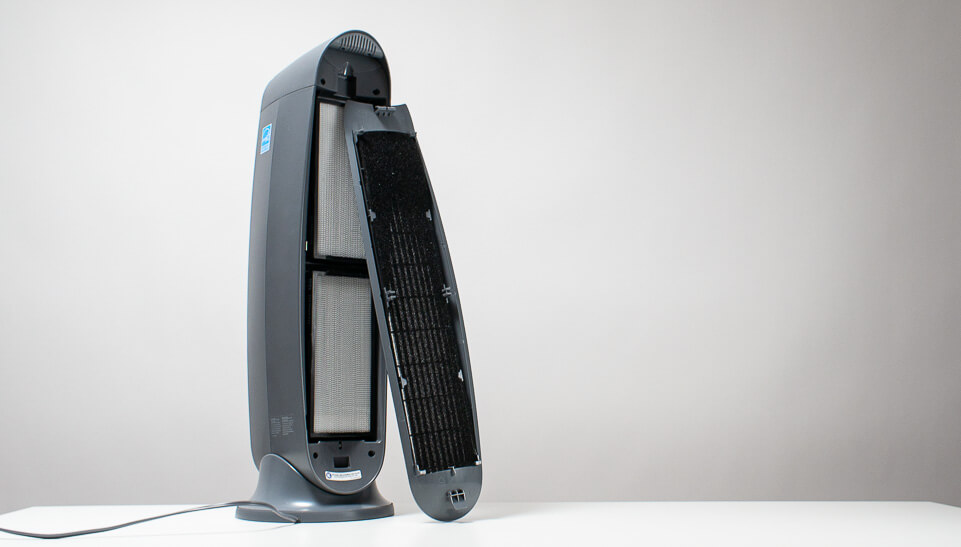
Feature Scores
Pros
- Forward facing outlets and oscillation allows unit to double as a fan
Cons
- No HEPA filter – unit is equipped with a permanent washable filter instead which makes for inferior particle filtration
- Not the best build quality or quality in materials
- Lacks features - no timer, no remote, etc.
- Control panel lights can’t be turned off
Editor's Score
Quick Facts
| Particle filter type | Permanent IFD Filter |
|---|---|
| Gas filter type | Optional carbon filter |
| Pre-Filter | Foam pre-filter OR optional carbon filter (which can double as pre-filter) |
| Output | Approx. 140 CFM |
| Air Movement | Back grille > foam OR carbon filter > 2x permanent IFD filters > 2x outlets on front of unit |
| Number of fan speeds | 3 - low, medium, high |
| Size | 30 in. tall x 9 in. wide x 10 in. deep |
| Weight | Just under 12 lb. |
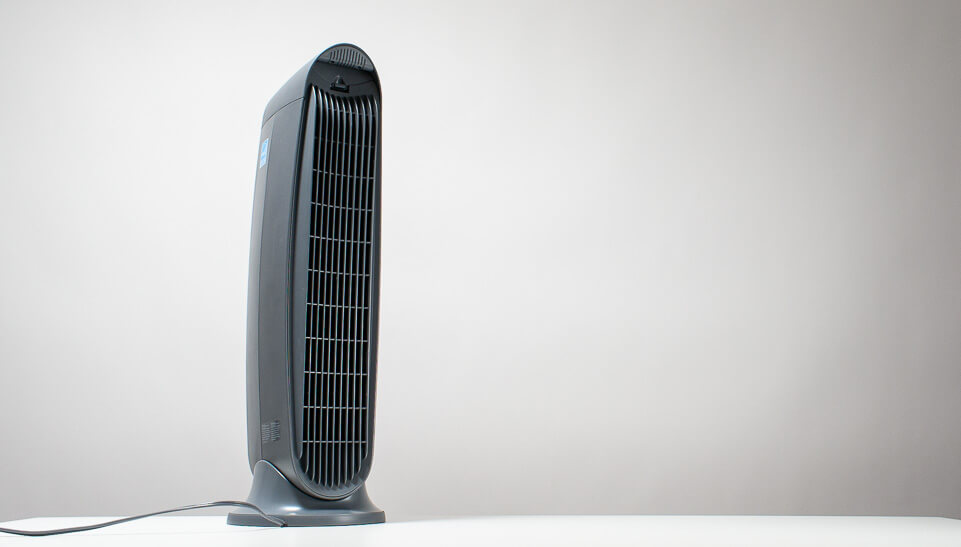
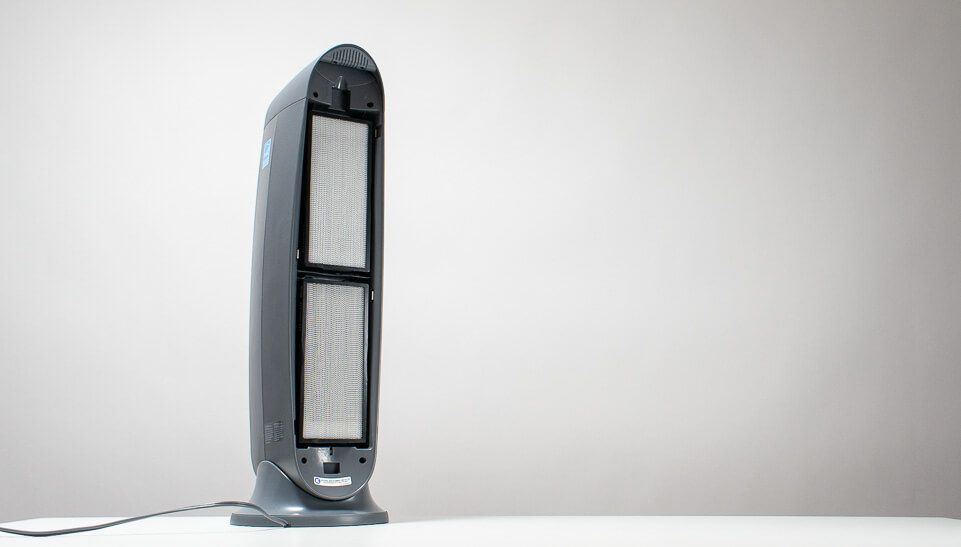
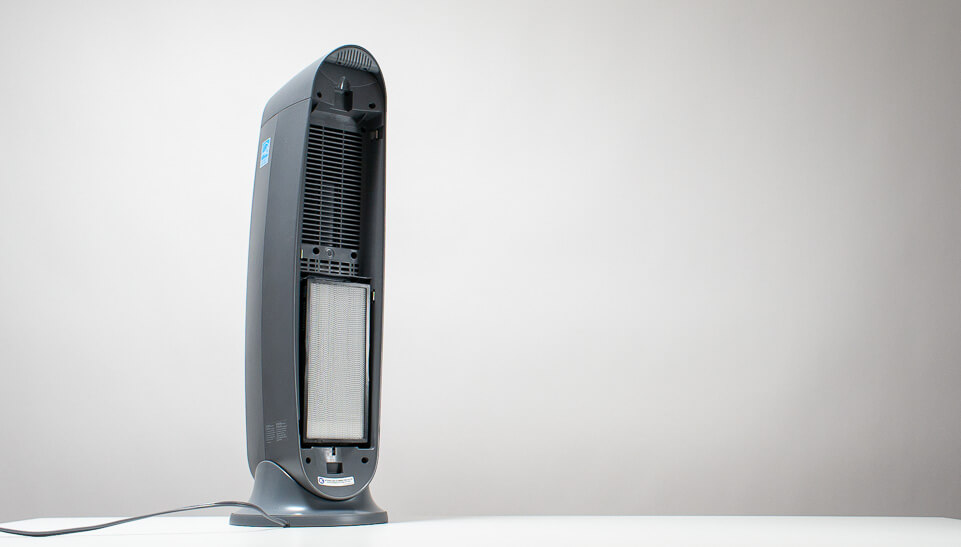
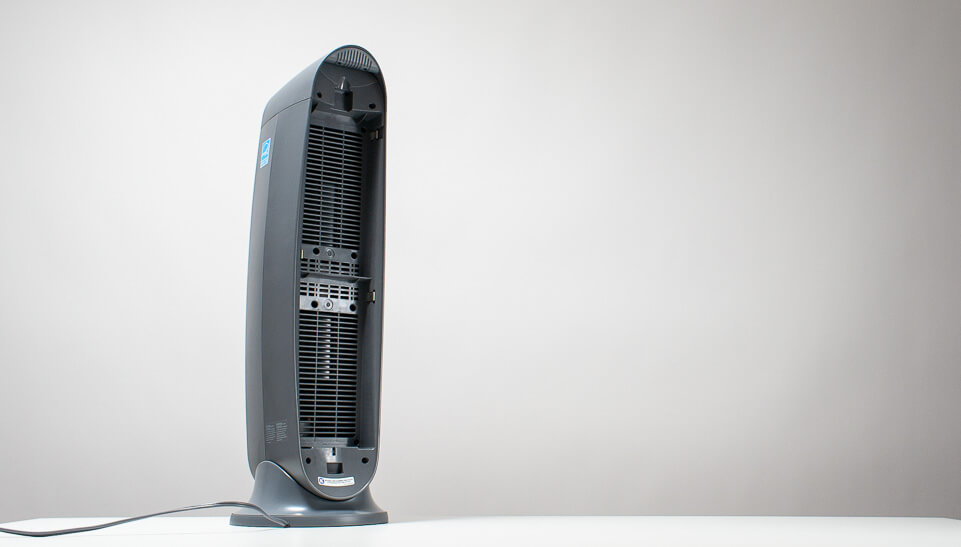
Analysis
A step by step breakdown of the HFD-120-Q's performance.
Air Processing Performance
Test Results
In an approx. 150 sq. ft. test environment, the HFD-120-Q with its permanent proprietary filters lowered room particle concentration from 10,000 particles down to 2,400 particles per cubic foot in 30 minutes. HEPA equipped units with similar output (CFM) took just about as long (in the 20 to 30 minute range) to lower particle concentration in the room down to 1,000 particles per cubic foot.
Given additional time, HEPA equipped units with similar output were able to lower particle concentration in the room even further – some were able to get it down to 500 particles per cubic foot. The HFD-120-Q could not lower it any further than 2,400 particles per cubic foot.
We consider 1,000 particles per cubic foot to be the maximum threshold for “clean air” in a residential setting. The HFD-120-Q was not able to get to this threshold of clean air. Compare this result to HEPA equipped units with similar output that were able to achieve particle concentration lower than 1,000 particles per cubic foot - as low as 500 particles per cubic foot in the same test.
The bottom line here is that the HFD-120-Q was not able to lower particle concentration effectively even in a small (150 sq. ft.) test environment. It was only able to achieve 2,400 particles per cubic foot, well above our 1,000 particles per cubic foot clean air threshold.
Filter Analysis
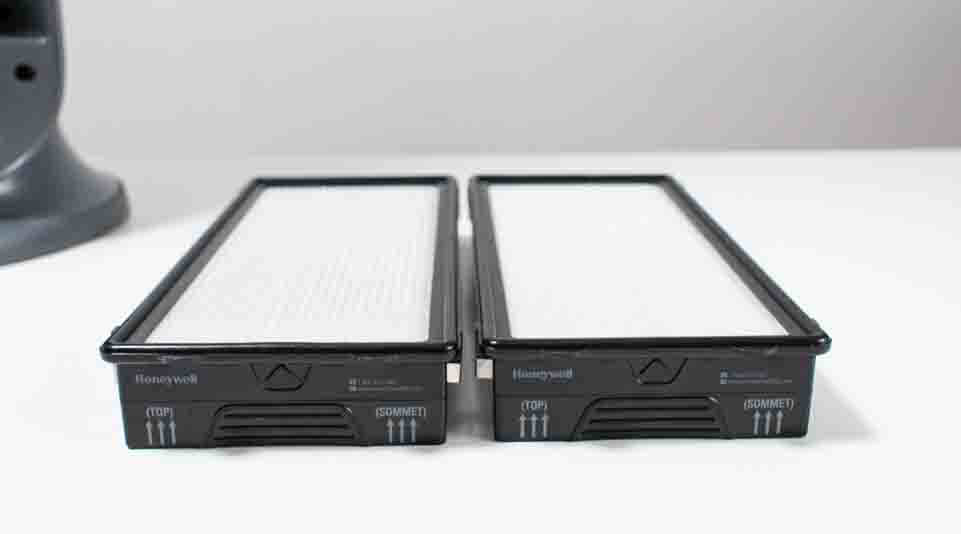
The HFD-120-Q is equipped with two permanent filters (see photo above) for particle filtration (dust, mold, etc.). These filters do not work nearly as well as standard replaceable HEPA filters as we just demonstrated in the “test results” section above. However, they are permanent. So they can be washed (for free) instead of needing replacement (at cost).
You have two options for a secondary filter (on top of the permanent filters)
A foam filter
solely intended to be used as a pre-filter to filter out large particles
A carbon filter
to be used for gas filtration but also effectively doubles as a pre-filter for large particles
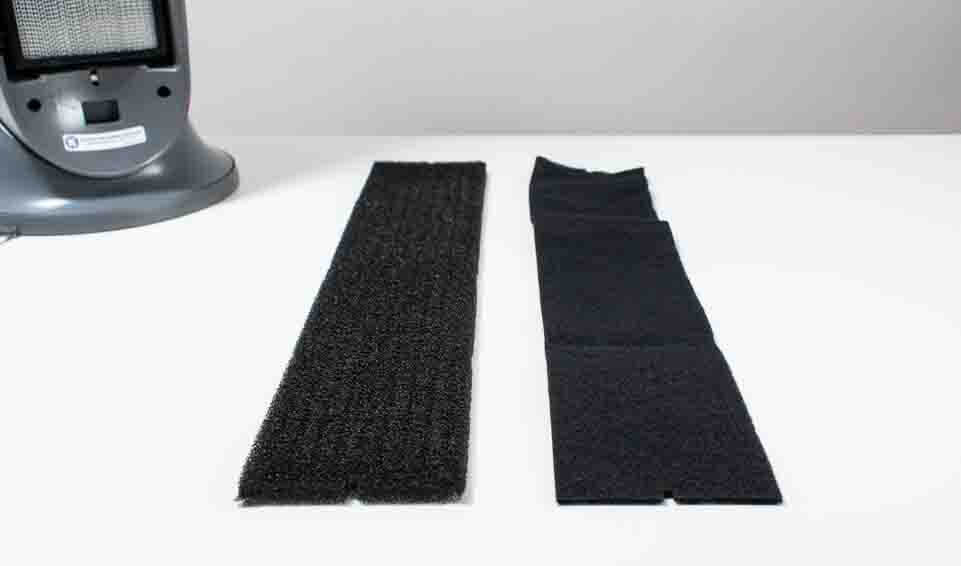
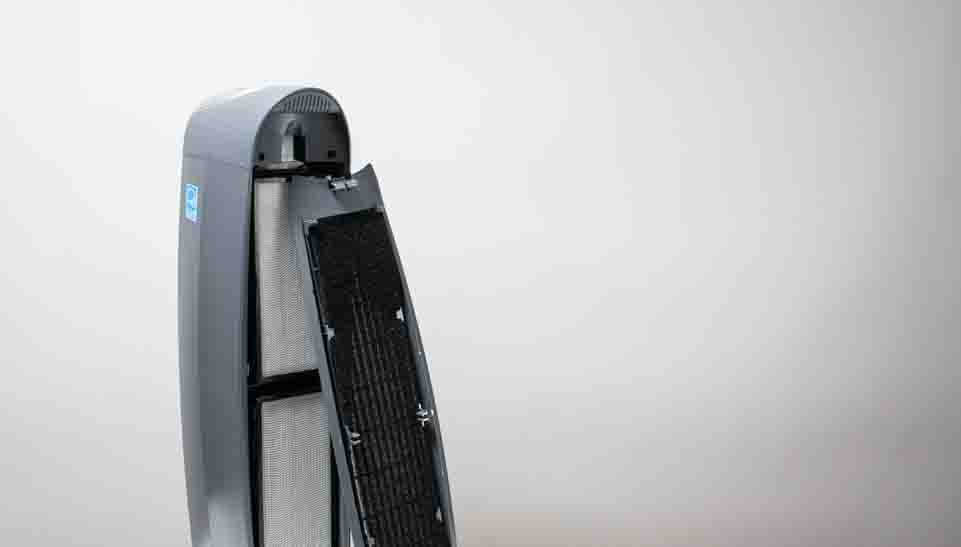
You cannot use both the foam filter and the carbon filter at the same time. While both filters are included when your purchase, the intention of the manufacturer is that you choose one or the other to install into the air purifier – not both.
The benefit of installing the foam filter is that you now have a fully functioning air purifier with fully permanent filters. The foam filter can be cleaned. It does not need to be replaced. The downside here is that there is no gas filtration.
The benefit of installing the carbon filter is that you now have gas filtration. In other words, the air purifier is able to filter out unwanted gases – odors and VOCs – with the carbon filter installed. The downside here is that you have to replace the carbon filter at cost.
Most other air purifiers at this price point have a very similar carbon filter with no option to go with a permanent foam filter instead.
Air Movement
The HFD-120-Q uniquely outputs through the front of the air purifier. There are two large outlets on the front of the unit behind the front grille. This allows for directional air flow allowing the unit to be used as a fan.
Most other air purifiers on the market output through the top – they cannot be used as fans.
The Honeywell also oscillates, further improving its ability to be used as a fan. Most other air purifiers on the market do not oscillate.
The HFD-120-Q outputs at approx. 140 CFM. This is theoretically enough output for a 150 to 200 sq. ft. room. However, output is only part of the puzzle in cleaning the air in a particularly sized room. Proper filtration is also critical and here the HFD-120-Q falls short with its permanent filters. Test results confirm our hands-on filter analysis.
Thus, we do not recommend this unit for any sized room if properly clean air is the ultimate goal. That is not to say that this unit won’t lower particle concentration. It certainly will. This unit will still work to lower particle concentration from extremely high levels down to lower levels. However, it’s incapable of getting room air to that extra low level (that clean air threshold we spoke about earlier) easily achieved when using a HEPA equipped unit with the same output.
Energy Efficiency
The HFD-120-Q exhibited average to slightly above average energy efficiency for its size. HEPA equipped units with similar output drew approximately the same amount of power during testing. For example, the GermGuardian AC4825 drew approx. 44 watts of power on max. settings and 34 watts of power on its lowest setting. The HFD-120-Q drew 34 watts of power on max. settings and 22 watts of power on its lowest setting.
The most energy efficient unit with similar output that we tested was the Blue Pure 411. It drew less than 10 watts on max. settings and only 1 or 2 watts on lower settings.
Noise Output
The HFD-120-Q garnered slightly above average noise output test results.
Do note that this was in large part due to how we conducted noise output testing. For noise output testing, we decided to position the sound meter slightly above and slightly in front of the top of the air purifiers. This placed the sound meter at a good distance and at a good angle relative to the primary noise generator on the air purifier (the outlet - where air comes out of it) for good consistent noise output test results.
The HFD-120-Q outputs out of the front out of two different outlets. The second outlet was a long distance away from the sound meter. This means that one of the two primary noise generators on the unit was a long distance away from the sound meter, giving this unit a distinct advantage in our testing.
Nonetheless, it performed quite well in our noise output testing, even compared to other units that had the same advantage – outputting out of the front instead of the top:
- HFD-120-Q - 46.5 dB on lowest, 55.4 dB on highest
- AirGenius 5 - 45.2 dB on lowest, 56.1 dB on highest
- AC4825 - 44.2 dB on lowest, 61.2 dB on highest
- AC4300 - 44.2 dB on lowest, 58.6 dB on highest
Durability
This unit was by no means one of the better built air purifiers we tested. In fact, it was just the opposite - the quality of parts and workmanship we observed when testing this unit was well below average.
The unit does have a very basic control panel – a good thing for long term reliability (vs having a lot of buttons/settings that can break). However, it also oscillates – a bad thing for long term reliability (this feature involves an additional motor that’s likely to be one of the first things that break on this low quality of an appliance).
The unit does come with a 5 year warranty which pushes its score slightly higher in the category.
Ease of Use
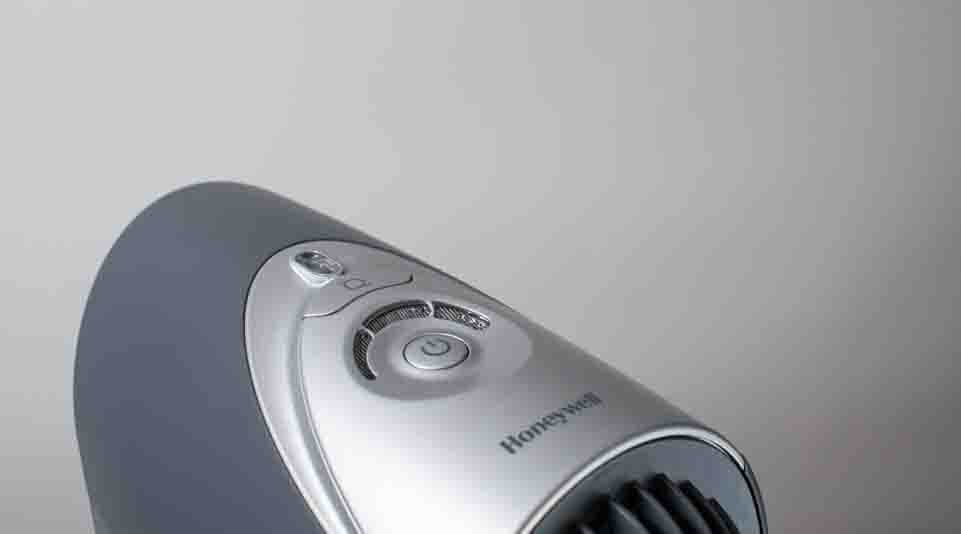
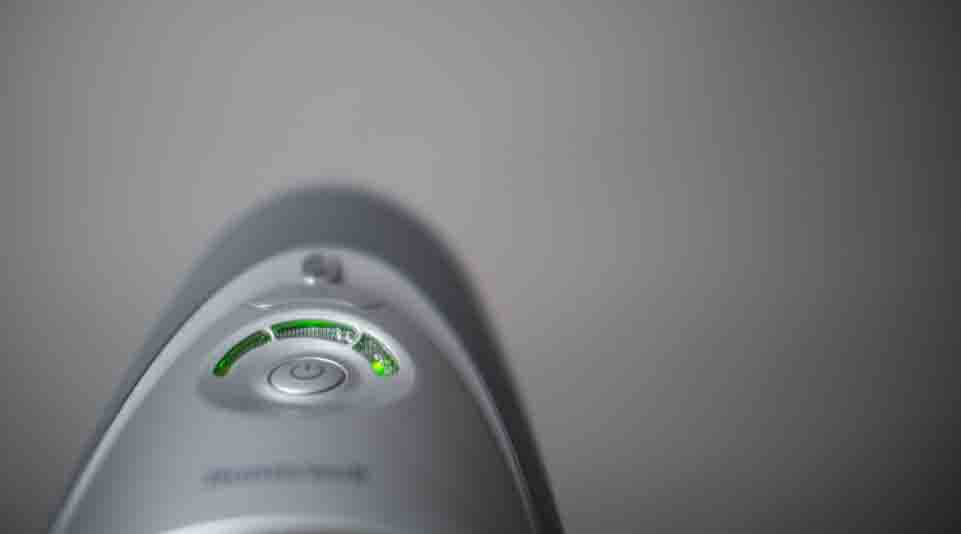
This unit scores below average in this category for the following reasons:
- There’s no way to turn the control panel LEDs off for users that want to use the unit in a dark room (and are users that are sensitive to lights being on in a dark room)
- There’s no timer, remote, or Smart functionality
Value
This unit would score well in this category if its permanent filters were just as effective as the industry standard for particle filtration - HEPA filters.
Permanent filters don’t need to be replaced at cost – potentially, a terrific value.
HEPA filters do need to be replaced – adding to the cost of owning a HEPA equipped air purifier over time
But the permanent filters installed on this unit are, quite simply, much worse filters than HEPA filters. So yes, you do get those potential cost savings but you’re getting them for a lesser product.
If you’re going through the trouble of buying an air purifier in the first place, particle filtration is important to you. You want to remove allergens, smoke, dust, or some other particle from the air in a particular room of your home. The HFD-120-Q does not do this nearly as well as a comparable HEPA equipped air purifier.
Is it the less expensive option over time? Yes.
Is it the better value option? No. Because value is not just about price. It’s also about what you get for your money. And we don’t think you get good enough particle filtration for the price when you buy this Honeywell air purifier.
Comparisons
How does this model compare to other air purifier options?
Compared to other units of the same brand
The AirGenius 5 is another Honeywell tower unit we tested. The AirGenius 5 has more fan speeds (5 instead of 3), a timer, and a mood light that can be turned on and off. The AirGenius 5 is also a higher CFM unit – around 170, 180 CFM vs 140 CFM for the HFD-120-Q.
Comparing the two units side by side it’s clear the AirGenius 5 is better built with higher quality parts. It also retails for quite a bit more – normally around $200.
Between the two we would recommend neither but if you’re dead set on buying a permanent filter unit we would recommend the AirGenius 5 because it is more feature rich, higher CFM, much better built option between the two.
Compared to top rated units
Both Honeywell towers work great as fans but not so much as air purifiers. Neither unit has a true HEPA filter. Although we’ve covered some of them in this review, for all of the reasons why we don’t like washable filters see our permanent filter air purifier guide here.
The HFD-120-Q also lacks the build quality and quality of materials used in top rated units.
The Honeywell is also less energy efficient. On its medium setting a top rated unit like the Coway Mighty outputs at close to the same level as the Honeywell on medium – slightly above 100 CFM.
The Honeywell on medium draws 24 watts of power vs less than 10 watts on the Coway.
Verdict
Our bottom line recommendations.
For the fact that it doesn’t have a true HEPA filter alone, we cannot recommend the HFD-120-Q. Instead we would recommend a top rated unit with a true HEPA filter. Something like the Coway Mighty or the Winix 5500-2 is our recommendation.
Add a Comment
Have a question or comment? Let us know below.

Comments